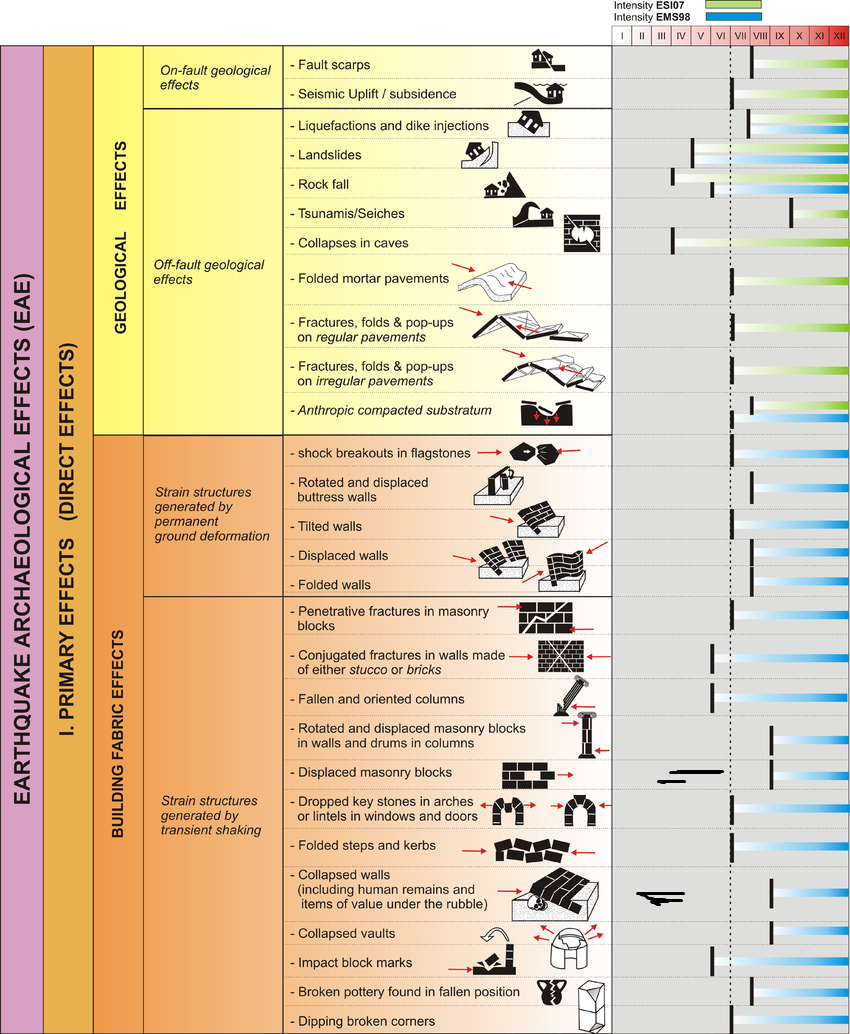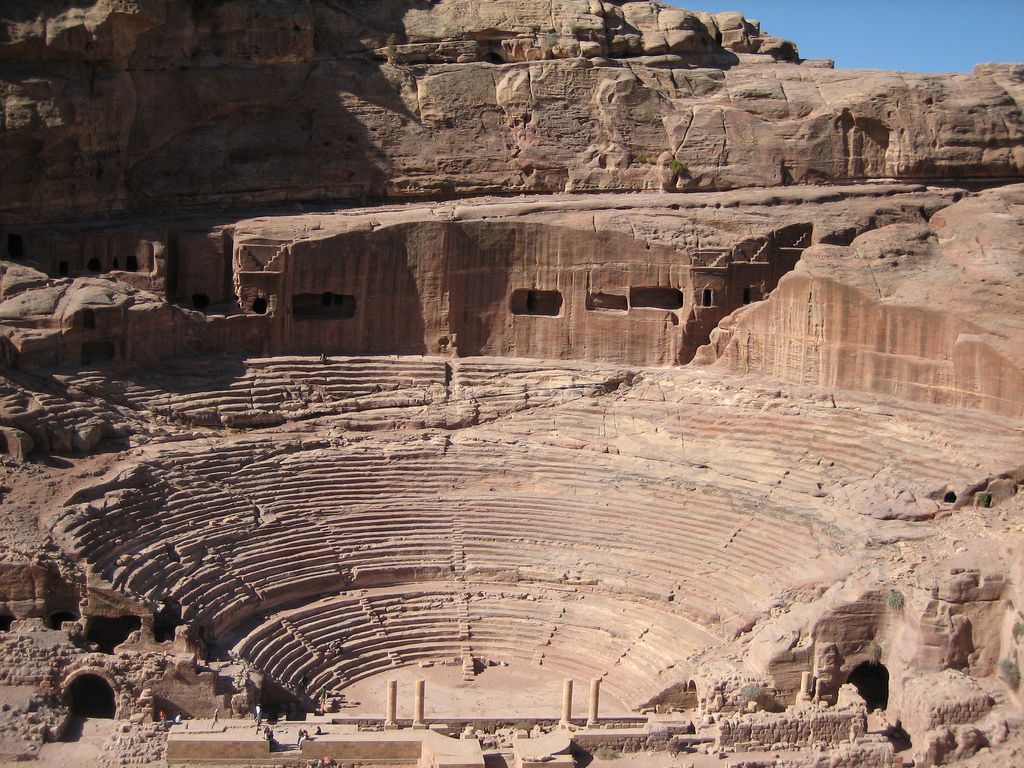Petra - Main Theater
 Aerial View of Petra Main Theater
Aerial View of Petra Main Theaterclick on image to open a high res magnifiable image in a new tab
Bernard Gagnon - Wikipedia - CC BY-SA 3.0
| Transliterated Name | Source | Name |
|---|---|---|
| Main Theater | English | |
| Petra Theater | English | |
| Masrah al-Batra | Arabic | مسرح البتراء |
As one enters Petra through the Siq, after passing "The "Treasury", the Main Theater is the first structure one encounters before entering the valley that comprises the central part of Petra. The seats are carved out of a cliff of Nubian Sandstone. Hammond (1964) excavated the Main Theater over two seasons in 1961 and 1962.
- from Petra - Introduction - click link to open new tab
- Pl. 90 - Plan of the Main Theatre
from McKenzie (1990)

 Pl. 90
Pl. 90
The Main Theatre - General Plan
McKenzie (1990) - Top View of the Main Theater
from Zamani Project

 Ampitheatre - Top view
Ampitheatre - Top view
Zamani Project - Fig. 14 - Plan of theater
from Tholbecq et al. (2022)

 Fig. 14
Fig. 14
General plan of the theater (2022)
(Ambroise Berthier)
Tholbecq et al. (2022) - Fig. 1 - Plan of theater
from Tholbecq et. al. (2023)

 Fig. 1
Fig. 1
General plan of the Petra theater, with the location of the 2022-2023 surveys
(Report and DAO A. Berthier 2022, supplements M. Kurdy 2023, MAFP)
Tholbecq et. al. (2023)
- Pl. 90 - Plan of the Main Theatre
from McKenzie (1990)

 Pl. 90
Pl. 90
The Main Theatre - General Plan
McKenzie (1990) - Top View of the Main Theater
from Zamani Project

 Ampitheatre - Top view
Ampitheatre - Top view
Zamani Project - Fig. 14 - Plan of theater
from Tholbecq et al. (2022)

 Fig. 14
Fig. 14
General plan of the theater (2022)
(Ambroise Berthier)
Tholbecq et al. (2022) - Fig. 1 - Plan of theater
from Tholbecq et. al. (2023)

 Fig. 1
Fig. 1
General plan of the Petra theater, with the location of the 2022-2023 surveys
(Report and DAO A. Berthier 2022, supplements M. Kurdy 2023, MAFP)
Tholbecq et. al. (2023)
- Fig. 5.35d - Section of the
Main Theatre from Rababeh (2005)

 Fig. 5.35d
Fig. 5.35d
Section elevation, showing the original slope and the line of cut.
(after Hammond 1965: Pl. XVI).
Rababeh (2005)
- from Hammond (1964)
- phasing is divided into 8 periods from bedrock to modern surface
- Initial construction and use appeared to occur during Nabatean times; likely soon after the reign of Aretas IV (r. 9 BCE - 40 CE) (Hammond, 1962:105-106).
- from Tholbecq (2022)
Hammond has, however, identified eight phases of occupation which, in our opinion, can be reduced to four major periods
| Phase | Date | Comments |
|---|---|---|
| 1 |
|
|
| 2 | probably in 363 and/or 419 CE |
|
| 3 |
|
|
| 4 | mid 8th century CE ? |
|
two phases have been securely identified, one dating from the turn of the 1st/2nd centuries AD, and a second corresponding to a major transformation of the stage building that occurred between the second half of the 2nd and the first half of the 3rd century. As the more recent levels of occupation were removed in 1961–1962, insights come from the pictures and drawings published in 1965 (Hammond 1965). The latest published material can be dated securely to the first half of the 5th century AD, indicating that the building was certainly reoccupied after the AD 363 earthquake. Unfortunately, all the archaeological material collected during these two rescue campaigns was destroyed in December 2023 by an arson attack that destroyed all the excavation material accumulated by the French and Belgian teams working in Petra over the last thirty years.
Russell (1980) reports that during the 1961–1962 seasons,
"Hammond (1965:13–17) found evidence of 4th century AD
architectural collapse while excavating the Main Theater". Based on stratigraphic
evidence and the recovery of two coins of
Constantine I (ruled 306–337 AD) and one of
Constantius II (ruled 337–361 AD), he dated the event to the mid-4th century.
Hammond (1964) labeled the destruction period as Period IV, stating that
"in this period the
scaena and its
stories,
blockade walls, the
tribunalia(e), and other built parts of the Theater were
all cataclysmically destroyed" while Hammond (1962) noted that the columns of the
scaena toppled "in marshaled rows," sculpted blocks shattered, and the
backdrop's architectural plan was "buried beneath tons of hewn and polished debris."
Tholbecq & Paridaens (2024) states that "the building was certainly reoccupied after
the AD 363 earthquake."
- from Chat GPT 4o, 6 July 2025
- from Hammond (1964)
Following this destruction, a "First Post-fall Period of Disuse" is marked by alternating layers of windblown and water-washed debris, suggesting abandonment and environmental infill after the collapse. A subsequent "First Post-fall Period of Re-use" is identified through two robbery-phase construction efforts, including a rebuild wall sealing the stage area and systematic blockage of exit routes, likely indicating short-term repurposing. Later reuse (Second Post-fall Period of Re-use) appears limited to casual occupation. Hammond notes no later destruction episodes with similar seismic implications.
Though Hammond does not explicitly link the destruction to a named earthquake, the scale and language of collapse—particularly the use of "cataclysmically destroyed"—align with seismic damage signatures seen in other Petra monuments. Based on regional parallels and other reports from Petra (e.g., Russell 1980; Hammond 1965), this event likely corresponds to the 363 CE Cyril Quake, though Hammond defers firm chronological attribution pending final analysis.
- from Chat GPT 4o, 6 July 2025
- from Hammond (1962)
This destruction, although undated within the article, is clearly seismic in character based on the vivid description of sudden, massive, directional collapse. Unlike later periods of casual reuse, this phase is sharply defined stratigraphically and marks a major discontinuity in the history of the theater.
No additional destruction events are reported in this article. Later phases are defined by non-structural reuse (e.g., robbing and pen-building), casual visitation, and sediment accumulation. Hammond does not link the collapse to a known historical earthquake, but based on the scale of damage and regional correlation, it may plausibly correspond to the 363 CE Cyril Quake, though no firm conclusion is offered in this preliminary report.
- from Chat GPT 4o, 6 July 2025
- from Tholbecq & Paridaens (2024)
No direct seismic destruction layer is identified in this report, but the chronology reinforces the interpretation from earlier excavations that associate a major collapse phase with the 363 CE event. The 2024 study does not contradict this attribution and instead supports a later phase of architectural reuse following seismic damage.
Unfortunately, all archaeological material from the campaigns was lost in a December 2023 arson fire, preventing further analysis of collected finds. However, finds recovered during the foundation probe included reworked ceramic material and bone fragments from a Nabataean necropolis likely destroyed during theater construction in the late 1st century BCE or early 1st century CE. These remains are not seismic in origin but highlight an earlier destruction episode predating the earthquake sequence.
- from Chat GPT 4o, 6 July 2025
- from Tholbecq (2022)
The 2021 campaign focused on a soundings trench in front of the theater's stage building. Below a Roman-period occupation layer, researchers identified residual fill that included Nabataean and early Roman ceramics, fragments of bone, and debris from an earlier funerary context (associated with tombs visible beneath the cavea). This material was likely displaced when the theater was originally built, and is unrelated to the later destruction phase.
No new seismic destruction phase is presented in this article. Instead, the team’s work confirms that the theater was reused and modified after the earthquake, aligning with the established interpretation that the structure continued to serve secondary functions into the 5th century CE.
- from Chat GPT 4o, 6 July 2025
- from Jones (2021)
A second destruction episode is reported for Phase VII. While Jones acknowledges the theater had already gone out of formal use by this time, he states that its destruction “may be the result of either the late 6th century earthquake or the mid-8th century earthquake.” The interpretation is limited by the absence of precise stratigraphic dating, but the possibility of later seismic collapse is supported by material disturbance and architectural disintegration patterns consistent with earthquake damage.
Both destruction phases are framed as seismic possibilities, though neither is conclusively demonstrated. Instead, Jones presents them as reasonable hypotheses based on a synthesis of stratigraphy, historical records, and architectural collapse. The report supports the broader interpretation that the Main Theater suffered multiple earthquake-related disruptions, beginning in the mid-4th century and potentially recurring into the Byzantine or early Islamic periods.
Jones (2021:3 Table 1) reports a second potential seismic destruction
of the Theater in Phase VII, noting that "the Phase VII destruction of the
Main Theatre is difficult to date, as the structure had gone out of use long
before." He adds that it "may be the result of either the late 6th century
earthquake or the mid-8th century earthquake."
Tholbecq (2022) suggests that final destruction of the main theater probably occurred
"in the middle of the 8th century (Hammond phase VIII)".
- from Chat GPT 4o, 6 July 2025
- from Jones (2021)
A second destruction episode is reported for Phase VII. While Jones acknowledges the theater had already gone out of formal use by this time, he states that its destruction “may be the result of either the late 6th century earthquake or the mid-8th century earthquake.” The interpretation is limited by the absence of precise stratigraphic dating, but the possibility of later seismic collapse is supported by material disturbance and architectural disintegration patterns consistent with earthquake damage.
Both destruction phases are framed as seismic possibilities, though neither is conclusively demonstrated. Instead, Jones presents them as reasonable hypotheses based on a synthesis of stratigraphy, historical records, and architectural collapse. The report supports the broader interpretation that the Main Theater suffered multiple earthquake-related disruptions, beginning in the mid-4th century and potentially recurring into the Byzantine or early Islamic periods.
| Effect | Location | Image(s) | Description |
|---|---|---|---|
| Collapsed Walls | Main Theater |
|
-
Earthquake Archeological Effects chart
of Rodríguez-Pascua et al (2013: 221-224)

 Earthquake Archeological Effects (EAE)
Earthquake Archeological Effects (EAE)
Rodríguez-Pascua et al (2013: 221-224)
| Effect | Location | Image(s) | Description | Intensity |
|---|---|---|---|---|
| Collapsed Walls | Main Theater |
|
VIII + |
Hammond, P. C. (1962). "Petra: The Excavation of the Main Theater." The American Scholar 32(1): 93-106.
Hammond, P. C. (1964). The Excavation of the Main Theater at Petra, 1961-1962, Bernard Quaritch, for Colt Archaeological Institute.
Hammond, P. C. (1996:7). The Temple of the Winged Lions, Petra, Jordan, 1973-1990, Petra Pub.
Hammond, P.C. (1964) The Excavation of the Main Theater At Petra, 1961-1962
Annual of the Department of Antiquities of Jordan 08/9
Jones, C. P. (2021) The southern Levantine earthquake of 418/419 AD and
the archaeology of Byzantine Petra, Levant 53(1): 1–16
Paradise, T. (1999) Analysis of Sandstone Weathering of the Roman Theater in Petra, Jordan
Annual of the Department of Antiquities of Jordan 43
Tholbecq, L. (2022) Mission archéologique française à Pétra (Jordanie).
Rapport des campagnes archéologiques 2022
Tholbecq, T. (2024) Petra: Main theater
, in Pearce Paul Creasman, Jack Green and China P. Shelton (Eds.), Archaeology in Jordan 4, 2022-2023 Seasons, p. 136-137
Tholbecq, L. & Paridaens, J. (2024) The Petra Theater (2022–2023):
New Investigations and New Perspectives,
ACOR Annual of Interdisciplinary Jordanian Studies 4: 211–232
Hammond, P. C. (1965). The Excavation of the Main Theater at Petra, 1961-1962: Final Report. London, Quaritch.
Tholbecq, L., et al. (2022). Mission archéologique française à Pétra. Rapport des campagnes archéologiques 2022.
Tholbecq, L., et al. (2023). Mission archéologique française à Pétra. Rapport des campagnes archéologiques 2023.


